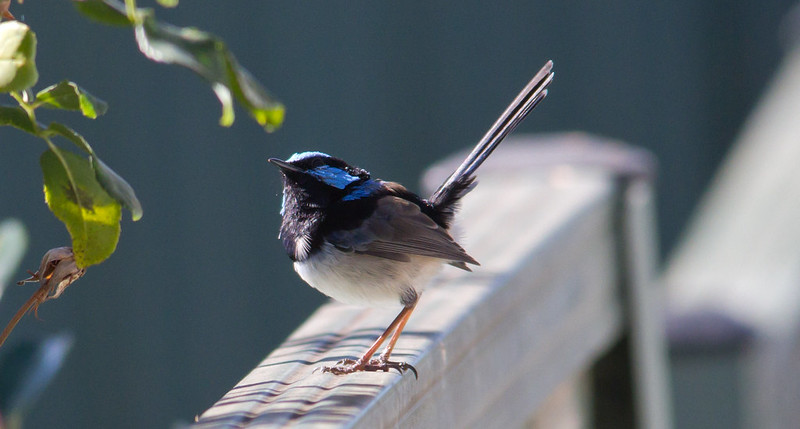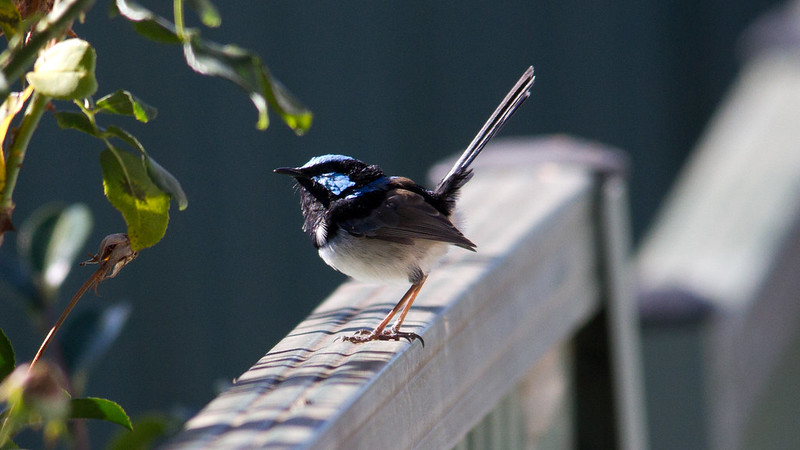Now correct me if i am wrong but shouldn't males have lost there breeding plumage by now?
These shots were taken at my place (in Canberra) about 3 hours ago.
 Superb fairy-Wren-2701 by rawshorty, on Flickr">[/url] Superb fairy-Wren-2701 by rawshorty, on Flickr
Superb fairy-Wren-2701 by rawshorty, on Flickr">[/url] Superb fairy-Wren-2701 by rawshorty, on Flickr
 Superb fairy-Wren-2700 by rawshorty, on Flickr">[/url] Superb fairy-Wren-2700 by rawshorty, on Flickr
Superb fairy-Wren-2700 by rawshorty, on Flickr">[/url] Superb fairy-Wren-2700 by rawshorty, on Flickr










Not if he's a senior citizen rawshorty Which, thanks to Woko, I found out only recently after I'd sighted one still in full plumage too.
Which, thanks to Woko, I found out only recently after I'd sighted one still in full plumage too.
Now, if I do this link right, have a look here http://www.birdsinbackyards.net/forum/More-Mr-Ms-Twiggy-Legs and all will be revealed
West Coast Tasmania
Gorgeous old gent by the way
West Coast Tasmania
Hi Shorty, if you have a close look at the chest of the wren, you should see, that the feathers are just starting to change.The light coloured feather is the first obvious change. I hope you read carefully what I said Shorty, I have explained the male eclipse in detail.
If you would like me to post about 30 photos of the wrens changing in sequence, I can do that.
M-L
And here's something a little extra to confuse and now somewhat challenge the 4yrs+ permanent breeding plumage discussion http://bioacoustics.cse.unsw.edu.au/birding-aus/2009-05/msg00373.html - the link in this is particularly interesting too, although perhaps a bit outdated. Would be nice to find something done in the last 10 years or so (unless I'm reading the date on the paper incorrectly). rawshorty, you would be in the perfect spot (perhaps ?) to find out if the Canberra Botanic Gardens are still doing this research?

West Coast Tasmania
A very interesting read.......looks like i'm off to the RBG on the weekend.(only a 10 min drive)
Shorty......Canon gear
Canberra
http://www.flickr.com/photos/rawshorty/
Fantastic! Would be great to know what you find out? Seems a rather old study - who knows, it may even be they may have found out since it was conducted incorrectly or......who knows. Be interesting to know if any other groups or Universities around the Country have done any studies too? Especially any "real people" studies, gathering information from people who see them every day in many different areas & have a positive advantage of real-place real-time information (like M-L). Can't say I can find anything - perhaps RBG can shed some light. Good luck!
Seems a rather old study - who knows, it may even be they may have found out since it was conducted incorrectly or......who knows. Be interesting to know if any other groups or Universities around the Country have done any studies too? Especially any "real people" studies, gathering information from people who see them every day in many different areas & have a positive advantage of real-place real-time information (like M-L). Can't say I can find anything - perhaps RBG can shed some light. Good luck!
West Coast Tasmania
I don’t mind sharing one more observation with you. Early this breeding season, after the male in breeding plumage lost his leg, while she was sitting on the nest, he was mostly sitting on the fence trying to cope. Two eggs actually hatched, but they disappeared.
She started to search for a “replacement husband” immediately, while he was still sitting on the fence. Only a few hours later I observed her engaging in some courting with another male. That male was not in breeding colours, I even saw them mating. So the idea that the dominant male changes into breeding plumage to impress the girl did not apply here. She chose him, (that’s how it works
immediately, while he was still sitting on the fence. Only a few hours later I observed her engaging in some courting with another male. That male was not in breeding colours, I even saw them mating. So the idea that the dominant male changes into breeding plumage to impress the girl did not apply here. She chose him, (that’s how it works ), and over the next week he changed into the beautiful colours. O, one more thing, although she had replaced the one legged male with a two legged male, I often saw her “catch up” with him behind the house
), and over the next week he changed into the beautiful colours. O, one more thing, although she had replaced the one legged male with a two legged male, I often saw her “catch up” with him behind the house .
.
M-L
OK, i went out to the RBG today and spoke to a gentleman at the visitor centre. He was aware of the research being done and i gave him my email for when he found out who was doing it. After spending several hours walking around the gardens and observing the wrens i arrived home to an email from the fellow i spoke to. The person doing the research is Professor Andrew Cockburn from the ANU.
From what i gather the males aged 1 to 2 get there breading plumage at the same time in spring but older birds can change earlier or later if they want.
http://www.researchgate.net/publication/51722692_Fluctuations_in_population_composition_dampen_the_impact_of_phenotypic_plasticity_on_trait_dynamics_in_superb_fairy-wrens
This is just a brief on the study, i did try to get the full article but it seems you need to be in a university or something to access it.
Maybe Holly could get it?
If you google Andrew Cockburn he has a lot of interesting articles on the Wrens.
Here is a male wearing his bling for the reaserch
Shorty......Canon gear
Canberra
http://www.flickr.com/photos/rawshorty/
Thanks Shorty, I'm not a Professor of anything, but I have come to the same conclusions all by myself. ( Just by observing hundreds of Wrens over the years.)
Not only that, but had to listen to some sarcastic remarks, and being somewhat made to look stupid. But as always in life, why should you listen to anything anyone without a degree says?
But even now, the findings of some University people have more credibility. Ah well, nothing new to me
If you read what I said above in my last post, there is also some of my backyard research, but who cares? I'm beginning not to anymore. Just keep on doing my own research, will enjoy what I observe , but not share anymore.
Good luck to all the researchers out there.
M-L
From reading the information in the above links it seems there's a number of factors involved in the moulting of superb fairy-wrens. The Reader's Digest Complete Book of Australian Birds information to which I referred is now 34 years old & lots of research has been done since then.
There's a male superb fairy-wren in breeding plumage about my place at present so I'll be paying close attention to any feather changes over the next few months.
Thanks for going to the trouble to find that out rawshorty. Wonder if there were any further blue to blue molts after that small percentage in '92 & any connections/correlation if so? Or if it was just an anomaly....hmmm - think I'll just continue to enjoy them no matter what colour, when colour - does my head in less
 .
.
West Coast Tasmania
No trouble at all Ruby, short drive and photographed birds on an excellent sunny day
I'm with you, i will just enjoy the birds no matter what they are doing
Shorty......Canon gear
Canberra
http://www.flickr.com/photos/rawshorty/
Ok i shot the male again today, still looks very colourfull.
Shorty......Canon gear
Canberra
http://www.flickr.com/photos/rawshorty/
.......probabely has seven gorgeous girls to keep him going , you wouldn't change anything if you had that, would you?
, you wouldn't change anything if you had that, would you?
M-L
Hi Shorty, I just found your photos on Google, under Superb Fairy Wrens. Click on "more images" up come a page with lots of photos of Wrens, about 6 of mine, also the Splendid Fairy Wren Nathan posted on BIBY.
M-L
Yep, that is how Google works. They provide links to information that you are searching for.
If they could not do this when searching for information about Superb Fairy Wrens you would get a page that says "Sorry your search has come up with no results"
Everything you put on the WWW is there for the hole World to see, even what i am typing now.
I never use my real name on the WWW for this reason.
Shorty......Canon gear
Canberra
http://www.flickr.com/photos/rawshorty/
Update, i have not seen my local male for some time now (but i have been busy), but i got a chance to get out today and went to the local wetlands and got a pic of the local male there. Sorry for the lousy pic but you can see he is molting his colour (10/6/13).
Shorty......Canon gear
Canberra
http://www.flickr.com/photos/rawshorty/
......how nice is that Shorty? I'm not saying, I told you so , but it makes me feel a lot better
, but it makes me feel a lot better Thanks for posting it.I feel somehow vindicated.
Thanks for posting it.I feel somehow vindicated.
M-L
Well another twist to the Wren saga. Winter is here and we have been getting quite a few -C temps.
Got this on Saturday at a different location of the wetlands.
Shorty......Canon gear
Canberra
http://www.flickr.com/photos/rawshorty/
I don't find this too unusual Shorty, if you have a close look, he is either moulting into, or out of breeding plumage. I saw a few of the wrens in my garden engage in some "flirting". Same last season, some start early, some last a bit longer. (just like human males )
)
I love the composition of the photo
M-L
I noticed the other day some of "ours" molting back into breeding plumage, this is obviously new, as we seem to have up to 6 or 8 males around all the time, and have not noticed the "change" until a few days ago. I still can't get any decent photos, too fast and too far away or not enough light (too much fog) but will keep trying. Thought it might be too early, being our winter, but from what M-L says it is probably fairly normal.
Dale Huonville, Tasmania
I'm observing the same on the s.e. slopes of the Mt Lofty Ranges.